

|
Home Updates Hydros Cars Engines Contacts Links Contact On The Wire ←Previous |
|
|
Nordec
Part III |
|
|
|
The final chapter To its great credit, the company was once again quick to recognize the residual problems with their product, and in the Spring of 1950 they elected to go whole hog and introduce a completely revised model which was quite openly based on the Series 20 McCoy, featuring far more open bypass and porting arrangements to go along with its improved combustion chamber design. The result was an entirely new model, the Nordec Special Series II. It appears to have been released only as a glow-plug model. |
|
As one might expect given the engine’s heritage, the performance of this model was a huge improvement over that of the earlier RG10 and Nordec Special Series I models. Peter Chinn tested the prototype of this model for the manufacturers and also covered both the Series I and Series II versions of the Special in a test report published in the June 1950 issue of 'Model Aircraft'. Published output of the latter model was a highly creditable 1.23 BHP at 15,200 rpm. Now that’s more like it!! Right: McCoy Series 20 showing similar style of transfer passage as used for the Series II Nordec |
|
What is significant about these tests were that they were carried out on prototypes, which had a one piece crankcase, similar to the McCoy. It is reported that the production versions of this motor would revert to the use of separate fins. Another major departure from the previous engines was the use of a one piece crank, rather than the built up version described earlier. By way of comparison, Chinn’s published November 1951 test of the Series 20 McCoy found 1.52 BHP at 16,100 rpm. Although this certainly bettered the performance of the stock Nordec Special Series II, it’s clear that the latter had finally made it at least into the outfield of the same ball-park as its American rival, performance-wise. It had always been a match for the McCoy in terms of quality, so it appeared that Nordec finally had the product that they needed to succeed.
However, it was a case of too little, too late, and the writing was already on the wall for the Nordec series. Unsurprisingly, sales of large racing engines in Britain were never brisk, leading to the company disappearing from the market soon after the introduction of the Nordec Special Series II
. A contributing factor was doubtless the failure in late 1950 of the legal case presented by the model trade to have British-made model goods exempted from Purchase Tax, which had been imposed by a change in schedules in 1948. This unfavourable outcome put a serious dent in the profit and pricing picture for model engine manufacturers in Britain as the tax was levied at 33% on all model parts and accessories (including engines), and it’s doubtful that North Downs Engineering were making much on the model engine side even before the failure of the case.The Nordec Special Series II was certainly produced as a protoytpe but there is considerable speculation amongst engine enthusiasts as to whether the production version of the Series II ever made it out of the factory gates. Extended enquiries failed to reveal a genuine example until 2020 when we were contacted by a Swiss enthusiast who had recognised the engine below that had been sitting in a Dooling F car since the 1950s. This is one of the prototype versions with the monoblock crankcase and there is a distinct possibility that it was one of Woods' own engines, given the yellow paint locking the screws, the same colour as his planes and the trimmed exhaust from a speed cowl. Still no examples of the production version with the separate fins though and if anyone has one then a photo would be very much appreciated.
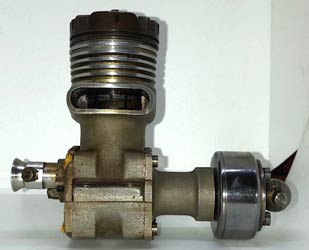 |
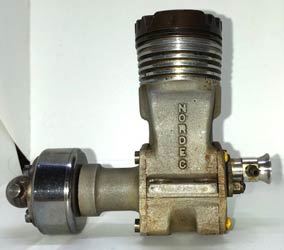 |
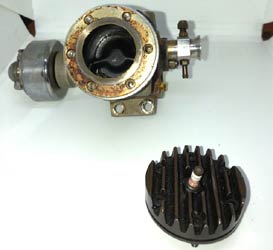 |
So the Nordec racing engine was gone, after a production life of a little over two years. The Ten-Sixty-Six Conqueror had departed the scene earlier in 1950, and the Rowell 60 was soon to follow. However, this was by not the end of the Nordec as John Wood and his Nordec Team continued flying under the 'works' banner for some time winning the Speed event at the Isle Of Man Rally in 1951.
|
|
In July 1950, the photo to the left appeared, described in the text as 'An entirely new engine by John Wood of the Croydon Club shows strains of Dooling, McCoy and the Nordec, for which Mr Wood was responsible'. More recently, two sets of monobloc castings came up for sale on ebay that closely resembled the Nordec, one of which clearly had Wood 10 cast into the transfer passage, almost certainly further examples of the motor seen here. This would seem to confirm that the Nordec Series II was the last engine to come from North Downs with false assumptions being made about the engine in the photo. Left: The 'Wood 10' |
The end of production of the Nordec Motors would seem to coincide with the closure of the Wapses Lodge facility in Whyteleafe and the transfer of the entire North Downs operation to the Westway Garage site. This may well have been to make way for a new roundabout, still known as the 'Wapses Lodge roundabout, and the Caterham bypass being built at that time.
It is presently unclear how long the company remained in operation, but it was certainly still in the manufacturing business as of 1959 promoting a revised supercharger system known as the Godfrey-Nordec system in addition to the well-established Marshall-Nordec installation, and was offering kits for such apparently unlikely 'muscle cars' as the Austin A35!! It later turned to car sales and vehicle rental as Westway Motor Rentals Ltd, although this company was wound up in the High Court in December 1963, where North Downs Engineering were noted as 'Motor Car Dealers'. No mention of North Downs Engineering can be found after this date, other than a planning application in 2006 to demolish the old disused Westway Garage site and re-develop the area.
Serial numbers and production figures
It appears that the Nordec engines were sequentially numbered starting from engine number 1. The presently-known range of serial numbers for complete examples of the original Nordec models goes from a low of 201 up to a current high of 870. However, my friend and colleague Alan Strutt reports that he owns used crankcase number 6, seemingly confirming that the sequence started at 1. Numbers for the spark and glow-plug models are more or less evenly distributed throughout the known range.
As far as the Special Series II goes, engine number 1040 of this type appeared as part of the Walton Collection when that wonderful assemblage was auctioned off. (Strangely, 1043 is a Series I Special glow.) The only other Special Series II of my present acquaintance forms part of Alan Strutt’s collection. This latter unit is equipped with the optional Nordec flywheel and clutch for car use, and bears the serial number 1126.
This relatively small sample does not decisively settle the question of whether or not the glow and spark models each had their own consecutive serial numbering system or if they were simply numbered sequentially as they came off the line, regardless of type. A further factor which suggests that the engines were numbered consecutively regardless of ignition type is the fact that the spark ignition version is considerably less commonly encountered today than the glow model. Even so, the highest recorded serial number for an original sparker is 870 while the original glow models only go up to number 827. If there were two parallel numbering sequences, this would imply if anything that the sparkers outnumbered the glow versions. In fact, the relative scarcity of surviving spark ignition models suggests that this was not the case. The observed data are most readily explained by the notion of a single numbering sequence covering both types, with the majority being glow-plug models.
The serial number is not the only mark on the engines. All of my examples (both spark and glow) also have a letter 'T' stamped into the top of the left-hand mounting lug, and a similar stamping has consistently been reported by others. It thus appears that this was a standard marking. I would assume that this most probably confirmed that the engine in question had been tested at the works. The instruction leaflet claimed that all engines were tested prior to despatch, and this may well be the meaning of this particular mark.
So how many were made? Impossible to say, but present indications based on known serial numbers are that between 1100 and 1200 engines of all types were produced in total over the two years or so during which production continued. Of these, it appears unlikely that more than 300 or so were of the 'Special' variety. If more data become available in the future, it may be possible to revise these figures somewhat, but they are unlikely to be far out. Whatever the number, it's clear that sales cannot have been all that brisk or production would likely have continued.
Conclusion
The Nordec engines were extremely well-built and consequently very durable as well as being rather too large to simply 'lose'. Allied to the fact that there was relatively little scope or incentive for their use after the early 1950’s, these factors have ensured that a significant proportion of the engines which were produced have survived to the present day. They are still regularly encountered on offer from dealers, at swap meets and on eBay, changing hands for respectable but as-yet by no means outlandish prices. Being racing engines, many of them were modified in various ways, and hence the main challenge today for collectors is to find one that remains in more-or-less stock condition. The vast majority of Nordec motors which do turn up are the original R10 and RG10 models and less frequently the Series I Special.
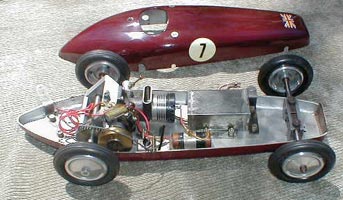 |
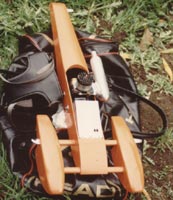 |
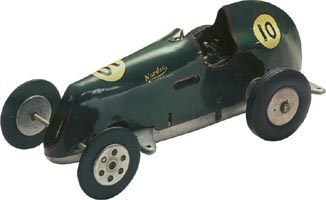 |
| Spur mounted Special 'sparker' in a 1066 Conquest | Special glow in a 'Lambert-Hyder' Vintage tethered hydro |
Nordecs were recommended for the
MCM 'Austin' based on a Warren & Clarke Pan |
There does remain an unanswered question as to just how serious the company was with the model engine side of the business. Whilst adverts do appear from retailers, only 3 adverts seems to have stemmed from North Downs and the first of these was not until March 1949 where the strap line was 'It's Hot'. The second ad was toned down somewhat claiming that 'For High Speed and Reliability you can't beat Nordec 10cc engines'. The final offering in January 1950 was 'Announcing' The Nordec Special, and reducing the price of earlier versions by £2 each, indicating that there were still several remaining unsold.
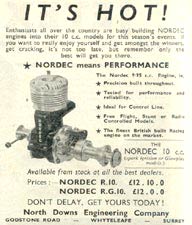 |
 |
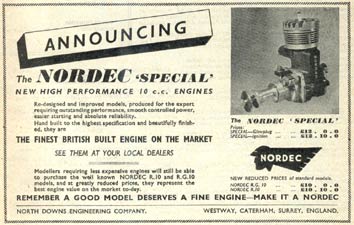 |
| Aeromodeller March 49 | Various modelling magazines April 49 | Jan 50. Address now Westway, Caterham |
Anyway, there we are - a brave British attempt to take on the McCoy and its relatives in the racing engine field, and one which was both very well-made and at the end was actually showing signs of approaching a comparable level of performance to that of its American rivals. It’s sad to reflect that the Nordec disappeared just when it was at last demonstrating some potential. It was a combination of time and place rather than any major deficiencies in the design, especially in its fully-developed form, that killed the Nordec series.
Still, on their intrinsic merits these engines undoubtedly deserve our favourable remembrance. Moreover, anyone giving one a test run will discover that they stand second to none in terms of their ability to turn money into noise! Go on, give one a go…….they can take it!
And to prove a point, vintage speed flying has become very popular, and around 2004, a smaller version of John Wood's 'Racer' was discovered, along with a heavily modified Nordec motor. The engine was rebuilt by Dick Roberts and the plane restored by its owner John Goodall. At Oakington in 2005, Dave Smith was persuaded to give it a first flight, which he reeled off at an amazing 110mph! OTW was present that day, and to see a 10cc plane being flown at that speed with no pylon or cage was awesome.
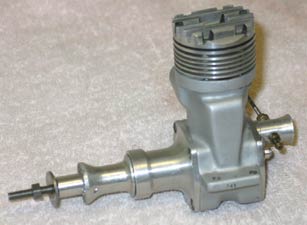 |
 |
| Heavily modified Series I Serial# 341 | Diminutive version of Wood's 'Racer' design |
Mind you, if it is noise you are after, one can only imagine what it must have been like at the Manx Rally on the Isle of Man in 1948, when appalling weather had John Wood making his flight INDOORS on short lines. Even a modest 66.2mph run must have shaken the wax from the ears?
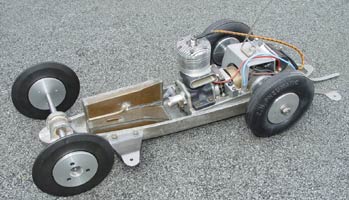 |
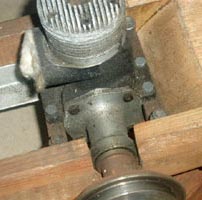 |
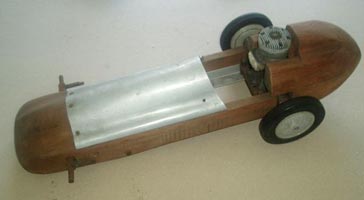 |
| Ian Moore 'Special' fitted with R10 | Single end, direct drive, RG 10 for this 'wooden wonder' | |
As a postscript, a while ago an enthusiast in
Devon was offered a large quantity of original Nordec engine parts that had been
recovered from a skip at some stage. These had then lain in
a shed for a while, gathering rust, but there were sufficient parts to build
entire engines. Stocks of pistons, liners and conrods have also come to light
with the pistons still being in greased paper ‘sticks’.
Our thanks go to
the following for information, photographs, leads, and related material.
Peter Hill, John Goodall, Dick Roberts, Eric Offen, Shirley
Russell, Stuart Robinson, Gary Maslin, Ron Reiter, Jim Free, Jim Hampton for
making the original suggestion that we should look at the Nordec and of course
Adrian Duncan for setting the whole thing in motion and allowing us to
use his extensive researched article.